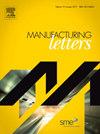在金属增材制造中应用设计复杂性指标进行后处理成本建模
IF 1.9
Q3 ENGINEERING, MANUFACTURING
引用次数: 0
摘要
近期的增材制造(AM)文献主要集中在探索改进当前技术及其适用性的新途径。此外,还深入开展研究投资,旨在解决与当前增材制造工艺相关的最后遗留的预测难题,尤其侧重于表面质量、精度和内部组成。这些限制通常可以通过应用后处理技术来缓解。当谈到形状复杂性对 AM 零件后加工成本的影响时,文献中的空白是显而易见的。近年来,越来越多的人开始关注通用形状复杂性指标的研究。有文献建议结合多种复杂度度量技术,以建立更全面的模型。在以往的研究中,这方面还没有得到足够的重视。此外,形状复杂度与后处理成本之间的关系也没有得到评估。本研究分析了用于原型制作的 AM 形状。在这方面,使用了之前建立的复杂性指标,并结合专家对后处理成本的评估,创建了一个能够预测后处理成本的模型。这是通过使用成本和复杂性指标值进行回归分析实现的。这项研究的成果是两个回归模型,分别命名为 7 V 和 Vol/Sur 模型,能够预测使用 SS316L 不锈钢粉末通过 DMLS 技术生产的 AM 零件的后处理成本。本文讨论了这两个模型的准确性。本文章由计算机程序翻译,如有差异,请以英文原文为准。
Applying design complexity metrics for post-processing cost modeling in metal additive manufacturing
The recent Additive manufacturing (AM) literature has primarily concentrated on exploring new avenues for improving the current technology and its applicability. It has also delved into research investments aimed at addressing the last remaining prediction challenges associated with current AM processes, particularly focusing to surface quality, accuracy, and internal composition. These limitations can often be mitigated though the application of post-processing techniques. Such techniques are often very costly both in time and monetary terms.
When it comes to the impact that shape complexity has on post-fabrication costs for AM parts, a gap in the literature is apparent. In recent years, more attention has been devoted to researching a general shape complexity metric. It has been suggested in the literature to combine multiple of complexity metrics techniques, to reach more comprehensive model. This aspect has not received enough attention in previous works. In addition, the relationship between shape complexity and post-processing costs has not been assessed. And there are no predictive models for post-processing costs based on complexity.
In this study, AM shapes for prototyping application are analysed. In this regard, previously established complexity metrics are used, together with expert’s assessments of post-processing costs, to create a model capable of predicting post-processing costs. This is achieved through a regression analysis using costs and complexity metrics values. The result of this research are two regression models, named 7 V and Vol/Sur Models, capable of predicting post-processing costs for AM parts produced through DMLS techniques with SS316L stainless steel powder. The accuracy of the two models is discussed.
求助全文
通过发布文献求助,成功后即可免费获取论文全文。
去求助
来源期刊

Manufacturing Letters
Engineering-Industrial and Manufacturing Engineering
CiteScore
4.20
自引率
5.10%
发文量
192
审稿时长
60 days
 求助内容:
求助内容: 应助结果提醒方式:
应助结果提醒方式:


